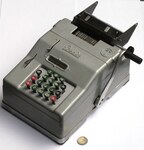
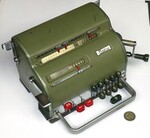
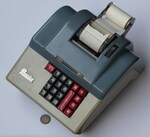
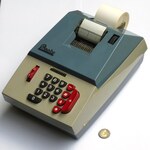
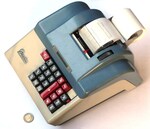
The Precisa 102-1 is a manually driven adding listing machine from about 1949 or 1950. It can add and subtract, and handles negative totals correctly.
The controls are as follows:
| 0-9 | Digit keys for inputting numbers | |
|---|---|---|
| 00 | Same as typing 0 twice | |
| 000 | Same as typing 0 three times | |
| C | Clear | Clears keyboard input without affecting anything else |
| +/- | Add/Subtract | Selects addition or subtraction mode |
| N | Non-Print | When this key is locked down, the printing and paper feed are disabled. |
| × | Multiply | When this key is locked down, the input is not cleared automatically after an adition/subtraction. |
| R | Recall | Recalls that last number that was printed and adds/subtracts it |
| # | Non-add | Print number with a # without changing the register |
| ⋄ | Subtotal | Print current register value with a ⋄ without clearing it; clear input |
| ∗ | Total | Print current register value with a ∗; clears register |
This model has some curious idiosyncrasies that may be confusing. In particular, the total (∗) and subtotal (⋄) are usually locked and cannot be pressed down. They are only unlocked when you pull the handle without any input, and set the Add/Subtract switch to match the sign of the register total. To get the (sub)total you therefore have to clear the input (if necessary), pull the lever, try pressing the (sub)total button and if it is still locked flip the add/subtract switch and press it again, and finally pull the lever a second time.
The Recall (R) functionality is quite rare in adding machines but can be very useful. If you add a number but only notice a typing error when it shows up on the paper, then you can press the R button, flip the add/subtract switch, and pull the lever to subtract the incorrect number and correct the mistake. Similarly, if you accidentally print a total instead of a subtotal, then you can recall the printed total to restore the register again. You can even recall a number printed with the Non-Add button. Note that the R button remains depressed after pulling the lever, so you have to press the clearing button to release it after use.
There are many safety interlocks on this machine. There is the aforementioned locking of the (sub)total buttons, but it is also impossible to enter leading zeros, or use the R button once a number has been entered.
The serial number of my machine is 69,527. It was in production from about 1949 till 1956, and this one is probably one of the earlier ones. It is very easy to open the case. The printing mechanism detaches by pressing a tab in its left side. The two larger screw heads on the bottom are actually connected to latches, so rotating them a quarter turn releases the case.
The Precisa 117 is a mechanical calculator that is clearly inspired by the design of the Facit. Like the Facit, it is a pinwheel machine where it is the input register that is mounted on a moving carriage instead of the main register and counter, and it has a Dalton style 10-key keyboard. The crank is positioned ergonomically at an angle towards the user.
Each of the three registers has a clearing lever. The front lever on the left clears the input register. The paddle below it is just a fixed support so that you can push down the input clearing lever using a squeezing motion. To the rear of the left side is the clearing lever for the main register, and on the right rear is a similar lever for the counter.
There are just 3 control keys. There are two arrow keys which simply shift the input carriage one step to the left or right. The key marked DIV shifts the input carriage all the way to the left, which is handy for division. It also affects the way the counter reacts. A single addition will not be registered, which allows you to enter the dividend, and any subtractions will be counted positively in order to perform the division calculation.
This model was in production from 1952 until 1963. The serial number is 151,193 which seems to be early in the production, say about 1953. Later versions have round handles on the clearing levers, a larger Precisa logo, and often are painted silver grey instead of green.
The Precisa 160 is an electrically driven adding listing machine. It has a 10-key keyboard, with a few control keys. This is the model 160-12, which means it allows input of 12-digit numbers, and has a 13-digit internal register.
This machine has a two-colour ink ribbon, so that it can print numbers that are subtracted in red. It does not handle negative totals properly however (it prints -1 as 99,999,999,999,99 in black), though it seems that later versions of this same model do (printing 1- in red). On the other hand it may be that this machine is simply not working properly.
The buttons are as follows:
| 0-9 | Digit keys for inputting numbers | |
|---|---|---|
| 00 | Same as typing 0 twice | |
| 000 | Same as typing 0 three times | |
| C | Clear | Clears input without affecting anything else |
| + | Add | Add number to register, print number with a +; clear input |
| - | Subtract | Subtract number from register, print number in red with a -; clear input |
| R | Repeat | Combine with + or - for repeated addition/subtraction without clearing input |
| # | Non-add | Print number with a #; clear input |
| ⋄ | Subtotal | Print register with a ⋄ without clearing it |
| ∗ | Total | Print register with a ∗; clear register |
The serial number is B913,352. The letter B indicates the machine was made in 1969.
The top part of the case can be lifted up to access the ink ribbon. The hinge is at the back, and the hinge axle can be pulled out to separate the two halves of the case and take out the mechanism.
The Precisa 208 is an electrically driven adding listing machine. It has a 10-key keyboard, with a few control keys. This is the model 208-8, which means it allows input of 8-digit numbers, and has a 9-digit internal register.
This machine has a two-colour ink ribbon, so that it can print numbers that are subtracted and negative (sub)totals in red.
The controls are almost the same as the Precisa 160 above, except that it does not have the double/triple zero buttons, and that the Repeat and Clear are not buttons but a lever that is moved up to clear the input and moved down to enable the Repeat mode.
The serial number is DC 19041. I think that the letter C is the year code indicating this machine was made in 1970.
The blue top part of the case can be lifted up to access the ink ribbon. The rest of the upper case is held on by a small metal plate retained by an e-clip on an axle.
The Precisa 364 is an electrically driven adding listing machine. It looks almost identical to model 160 above, except that it has an extra column of control keys and a switch. This is the model 364-12, which means it allows input of 12-digit numbers, and has a 13-digit internal register. The extra keys allow it to perform automatic multiplication.
This machine has a two-colour ink ribbon, so that it can print numbers that are subtracted in red. It handles negative totals correctly, printing the value in red with a minus sign at the end.
The controls are as follows:
| 0-9 | Digit keys for inputting numbers | |
|---|---|---|
| 00 | Same as typing 0 twice | |
| 000 | Same as typing 0 three times | |
| C | Clear | Clears input without affecting anything else |
| + | Add | Add number to register, print number with a +; clear input |
| - | Subtract | Subtract number from register, print number in red with a -; clear input |
| × | Multiply | Set first factor of a multiplication without affecting register; clear input. The × key is blocked if a first factor has already been set. |
| R | Repeat | Combine with + or - for repeated addition/subtraction without clearing input. Combine with × to set first factor without clearing input. The R key is blocked if a first factor has been set. |
| # | Non-add | Print number with a #; clear input |
| ⋄ | Subtotal | Print register with a ⋄ without clearing it; clear input; does not clear first factor |
| ∗ | Total | Print register with a ∗; clear register; clear input; does not clear first factor if present. When combined with $times;, total is set as first factor. |
| | | Neg. Mult. | This switch sets that the product is to be subtracted |
| ⋄ | Sub-Mult. | Print second factor with a =; multiply by first factor and add/subtract to register; clear first factor; clear input; print register with a ⋄ without clearing it. The key is blocked if no first factor was set or if the two factors together have more than 12 digits. |
| ∗ | End Mult. | Print second factor with a =; multiply by first factor and add/subtract to register; clear first factor; clear input; print register with a ∗; clear register. The key is blocked if no first factor was set or if the two factors together have more than 12 digits. |
The serial number is D130,901. The letter D indicates the machine was made in 1971.
The top part of the case can be lifted up to access the ink ribbon. There is also a jumper with which you can select which mains voltage is used (110-160V or 180-250V). The hinge is at the back, and the hinge axle can be pulled out to separate the two halves of the case and then take out the mechanism.
Ernst Jost founded the company Ernst Jost AG in Zürich, Switzerland, in 1916. He sold office machinery, including calculators such as Brunsviga and Rheinmetall. In around 1930 he must have decided that there was a market for a new adding-listing machine, and he enlisted the help of some engineers to make that happen, including Erwin Jahnz who had designed the first MADAS machines. In 1935 they founded the Precisa company in order to manufacture the prototype they had made, and production started in 1937 or 1938. Jost's office machine company was sold to Theo Muggli (see Direct). In 1942 the production was moved to Zürich - Oerlikon.
Precisa made many improvements to their adding machine, and made many other variants of it over the years. They only ever made one non-printing calculator, which was the model 117 shown above.
In 1964 Precisa merged with Hermes, a company that mostly made typewriters, and became Hermes-Precisa International. The calculators continued to be marketed using the Precisa brand name, though in some territories they were rebadged as Hermes. The mechanical calculator market collapsed with the arrival of electronic calculators, but the company managed to continue making mechanical calculators and typewriters until 1978 when it was bought by Olivetti.
It should be noted that Hermes-Precisa had also begun diversifying, by manufacturing precision scales and other measuring equipment. This part of the company seems to have been split off as an independent entity when Olivetti bought the rest, and it still continues today as Precisa Gravimetrics.
The first Precisa adding machine was the model M 1 from 1936. It was able to handle negative totals. In about 1944 it was replaced by three new models: The M 2 was a redesign of the M 1, available in both manual and electric versions, while the M 3 was a cheaper version with a smaller capacity. Later the M 4 was introduced which provided new functionality in the form of an extra totaliser register.
The model designations then become incredibly confusing. It seems that the M models were renamed in around 1948, and many variants were introduced with different paper feeding options. When the casing was restyled in around 1957, the same model numbers were sometimes used. In the table below I have listed only some of the many models, grouped into visually similar types. All the information is based on Rechner lexikon, combined with a fair amount of guesswork.
| Name | Years | Capacity | Notes |
|---|---|---|---|
| Precisa M 1 | 1935-1944 | 10×11 | |
| Precisa M 2 | 1944-1948? | 10×11 | In manual and electric versions |
| Precisa M 3 | 1944-1948? | 7×8 | Smaller capacity |
| Precisa M 4 | 194?-1948? | 10×(11+11) | Extra register |
| Precisa 102 | 1949?-1957 | 10×11 | Same as M 2, manual only. |
| Precisa 103 | 1949?-1957 | 7×8 | Same as M 3. |
| Precisa 104 | 1949?-1957 | 10×(11+11) | Same as M 4. |
| Precisa 106 | 1950?-1957 | 10×11 | Similar to M 2 / 102 but (sub)total buttons near lever, negative numbers printed in red. |
| Precisa 110 | 1949?-1957 | 10×11 | Electric version of the M 2 / 102. |
| There was often an extra digit appended to the model number, e.g. 102-1 or 1021, where the digit specifies the specific variant. For example, 1 and 2 variants have paper rolls, while 4 means it has a typewriter-style wide paper carriage, and 5 a wide split carriage handling both a paper roll and sheets. | |||
| Precisa 117 | 1952-1963 | 9×8×13 | Pinwheel calculator. Non-printing. |
| Precisa 103 | 1957-1962 | 7×8 | Restyled version. |
| Precisa 106 | 1957-1962 | 10×11 | Restyled version. |
| Precisa 110 | 1957-1962 | 10×11 | Restyled version. Electric. |
| Precisa 182 | 1957-1963 | 12×(13+13) | Electric. |
| Precisa 176 | 1957-1963 | 12×(13+13) | Electric. Multiplication. |
| Precisa 170 | 1957-1963 | 17×(17+17) | Electric. Multiplication and division. |
| Precisa 108 | 1961-1978 | 8×9 or 10×11 | Manual. |
| Precisa 208 | 1961-1978 | 8×9 or 10×11 | Electric. |
| Precisa 308 | 1969-1978 | 10×5×11 | Electric. Multiplication. |
| Precisa 160 | 1961-1975 | 8×9 or 12×13 | Electric. |
| Precisa 162 | 1963-1975 | 12×13 | Electric. Storage register. |
| Precisa 364 | 1963-1978 | 12×13 | Electric. Multiplication. |
| Precisa 164 | 1963-1978 | 12×13 | Electric. Multiplication. Storage register |
| Precisa 166 | 1966-1978 | 12×13 | Electric. Multiplication and division. |
From 1968 the serial numbers were changed to use a letter prefix to indicate the year. The 108/208/308 had two-letter prefixes, though it seems that the second letter indicated the year.
|
A=1968 B=1969 C=1970 D=1971 E=1972 |
F=1973 G=1974 H=1975 J=1976 K=1977 |
Gebrauchsanweisung der Precisa M3 (PDF, 4.61 MB or archive.org)
Precisa AG
Form 133
1944?
12 page stapled booklet
148mm × 210mm
This is the German instruction manual for the Precisa model M3. It has no copyright date, but this model was introduced in about 1944.
Gebrauchsanweisung der Precisa-Electra (PDF, 4.84 MB or archive.org)
Precisa AG
Form 136
1950?
15 page stapled booklet
149mm × 210mm
This is the German instruction manual for the Precisa-Electra, or model 110. It has no copyright date, but this model was introduced in about 1950.
Precisa Electric Gebrauchsanweisung (PDF, 5.67 MB or archive.org)
Precisa AG
1957?
18 page stapled booklet
148mm × 210mm
This is the German instruction manual for the Precisa Electric, also known as the Precisa 110. It has no copyright date, but the illustrations show the redesigned version of the model which was introduced in about 1957.
Precisa Mod. 364 Gebrauchs-Anleitung (PDF, 2.48 MB or archive.org)
Precisa AG
1963-1978
24 page stapled booklet
90mm × 150mm
Precisa Mod. 166 Gebrauchs-Anleitung (PDF, 4.57 MB or archive.org)
Precisa AG
1966-1978
44 page stapled booklet
90mm × 150mm
Precisa 164 advertising leaflet
Precisa AG
1966-1978
Folded leaflet
147mm × 210mm
This German 4-page leaflet advertises a Precisa adding machine. The model number is not shown anywhere, but it seems to be the model 164.
Precisa Reciprocal chart
Precisa LTD
1961?
39-page stapled booklet
106mm × 210mm
This booklet has a table listing the reciprocals of 1000 to 9999. The first pages have instructions in German, French, English, and Spanish. There is no copyright date, but the blue-white cover suggests it was printed in the 1960s or 70s when Precisa's calculators had the same colours.
Here are a few adverts and articles found mostly in various newspapers and magazines.
Erwin Jahnz and Precisa filed very many patents on all aspects of the mechanisms of the machines. Below is a small selection of them.
| Patent | Filing date | Publish date | Name | Description |
|---|---|---|---|---|
| CH 146,299 | 15-04-1930 | 16-06-1931 | Erwin Jahnz | Reversing gear |
| CH 184,044 | 07-10-1942 | 02-09-1946 | Eugen Benninger | Pegboard for input storage
See also: US 2,062,963 |
| CH 286,904 | 15-11-1952 | 02-03-1953 | Precisa A.G. | Input lock (model 117)
See also: BE 506,601, DE 928,430 |
| CH 289,420 | 15-03-1951 | 01-07-1953 | Precisa A.G. | Division key lock (model 117) |
| CH 300,652 | 06-02-1952 | 16-10-1954 | Precisa A.G. | Calculator (model 117) |
| BE 509,804 | 08-03-1952 | 31-03-1952 | Precisa S.A. | Input lock (model 117) |
| CH 309,578 | 11-02-1953 | 16-11-1955 | Precisa A.G. | Soundproofing for keyboard |
| DE 1,091,782 | 09-02-1954 | 27-10-1960 | Precisa A.G. | Division setting (model 117)
See also: SE 181,163 |
| CH 345,183 | 11-06-1956 | 29-04-1960 | Precisa A.G. | Automatic division |
| CH 379,808 | 06-07-1960 | 15-07-1964 | Precisa A.G. | 10-key input (model 160)
See also: DE 1,215,407, SE 187,907, US 3,114,502 |
| CH 380,415 | 06-07-1960 | 31-07-1964 | Precisa A.G. | 10-key input (model 160)
See also: US 3,147,919 |
| CH 392,941 | 05-04-1962 | 31-05-1965 | Precisa A.G. | Printing mechanism (model 160)
See also: DE 1,449,510, FR 1,355,921, US 3,221,644, US 3,262,385 |
| CH 406,684 | 12-06-1963 | 31-01-1966 | Precisa A.G. | Multiplication limiter (model 164)
See also: US 3,312,391 |
| CH 412,412 | 12-06-1963 | 30-04-1966 | Precisa A.G. | Multiplication mechanism (model 164)
See also: US 3,268,165 |
© Copyright 2021-2022 Jaap Scherphuis, mechcalc a t jaapsch d o t net.